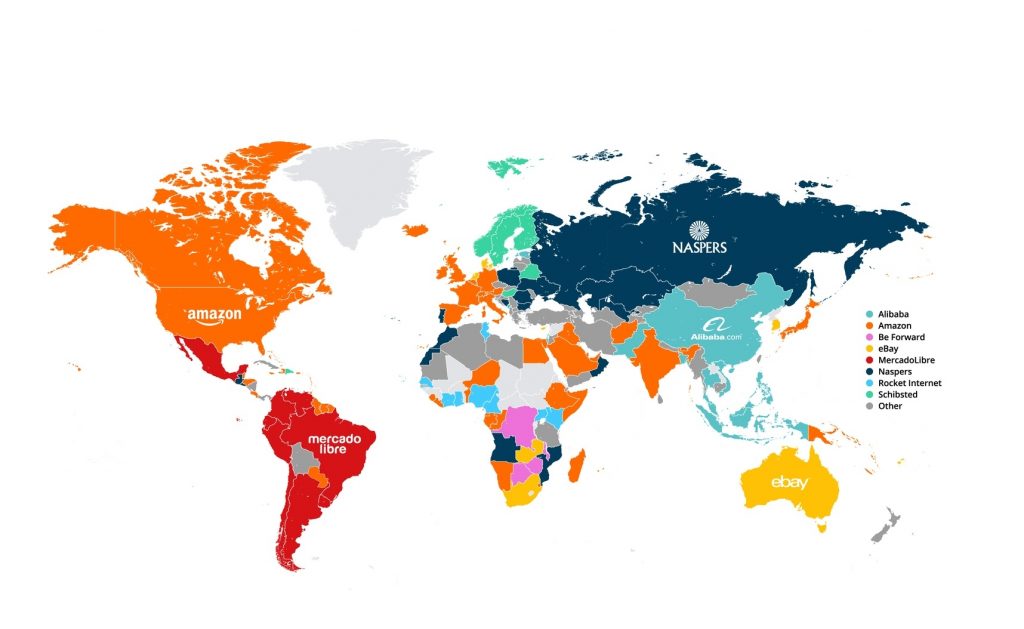In this post, we compare the world’s leading eCommerce marketplace platforms – Alibaba and eBay. Firstly, we look at the gross merchandise volume (GMV) of Alibaba and eBay for the years 2012 to 2015. Then, compare the number of annual active buyers that use these marketplace platforms. Finally, we compare the mobile commerce volume (MCV) or mobile GMV of Alibaba and eBay for the years 2012 to 2015.
Alibaba And eBay Business Models Are Very Similar
Alibaba and eBay business models have a lot in common. Both of the companies have built eCommerce platforms that connect buyers with sellers. Their marketplaces enable individuals and businesses to buy and sell online. Both of the companies do not hold inventory, unlike Amazon. Both of the companies generate revenues primarily from the transactions they enable and the marketing services they offer.
eBay was founded in 1995 and went public in 1998. eBay marketplaces are available across the globe. eBay operates its core global ecommerce platform at ebay.com and its other localized sites around the world such as eBay.de and eBay.co.uk. It also operates vertical shopping websites such as StubHub and classifieds websites such as Marktplaats.nl and mobile.de. eBay mobile app is available in 8 languages and 190 countries.
Alibaba was founded in 1999 and went public in 2014. Alibaba derives substantially all of its revenue from China. It is not as global as eBay. Alibaba operates the following retail marketplaces for consumers in China:
- Taobao Marketplace – China’s largest online shopping destination
- Tmall Platform – China’s largest third-party platform for brands and retailers
- Juhuasuan – China’s most popular group buying marketplace by its monthly active users
In addition to these three marketplaces, Alibaba operates
- Alibaba.com – Global wholesale marketplace
- 1688.com – China wholesale marketplace
- AliExpress – Global consumer marketplace
To compare the two platforms size, we will look at the following questions:
- How many active buyers do they have?
- What is total value of successfully closed transactions over their platforms?
- What is the total value of transactions that was confirmed over their mobile apps or mobile website?

Alibaba GMV Was Over 5.7-Times More Than eBay GMV In 2015
Both Alibaba and eBay have a similar definition of gross merchandise volume (GMV). It is defined as the total value of confirmed orders or closed transactions over their marketplace platforms, regardless of whether the buyer and the seller actually complete or settle the transaction. GMV is a measure of the volume of eCommerce enabled by the platform.
In 2015, 41% of eBay GMV was from U.S. and 59% of eBay GMV was International (i.e., outside the U.S.).
Alibaba reports GMV only for the three retail marketplaces in China – Taobao Marketplace, Tmall, and Juhuasuan.
Alibaba had a much faster growth in GMV than eBay from 2012 to 2015. In 2012, Alibaba GMV was $153 billion and eBay GMV was $68 billion. So, in 2012, Alibaba GMV was 2.3-times more than eBay GMV. In 2015, Alibaba GMV reached $466 billion, whereas eBay GMV reached $82 billion. So, in 2015, Alibaba GMV was 5.7-times more than eBay GMV.
Another way to appreciate Alibaba’s GMV growth is to look at the incremental GMV. It is the additional GMV in a year as compared to the previous year. In terms of incremental GMV, Alibaba has added more incremental GMV every year during the last three years than the eBay’s total GMV during a year. For example, in 2015, Alibaba had $99 billion of incremental GMV (calculated by subtracting $367 billion GMV in 2014 from $466 billion GMV in 2015). It is more than eBay total GMV of $82 billion in 2015.
Alibaba Had 2.5-Times More Annual Active Buyers Than eBay At The End Of Q4 2015
Both Alibaba and eBay have a similar definition of active buyers. It refers to all the buyers who successfully closed a transaction on their Marketplace platforms in the previous 12-month period.
In Q4 2012, Alibaba had 160 million active buyers and eBay had 112 million active buyers. So, in Q4 2012, Alibaba had 1.4-times more active buyers than eBay. In Q4 2015, the number of active buyers on Alibaba reached 407 million, whereas the number of active buyers on eBay reached 162 million. So, in Q4 2015, Alibaba had 2.5-times more active buyers than eBay.

Alibaba Mobile Commerce Volume Was Over 8.5-Times Bigger Than eBay Mobile Commerce Volume In 2015
Mobile commerce is growing for both the companies. But, the growth has been huge for Alibaba. Mobile commerce volume (MCV) or Mobile GMV refers to the same thing. It is the portion of GMV generated by orders that are confirmed using a mobile app or mobile website.
In 2012, Alibaba had mobile GMV was $8 billion. This represented 5% of Alibaba’s total GMV. In 2012, eBay had $13 billion mobile GMV. This represented 19% of eBay’s total GMV.
In 2015, Alibaba mobile GMV reached $279 billion. This represented 60% of Alibaba’s total GMV. In 2015, eBay mobile GMV was $33 billion. This represented 40% of eBay’s total GMV. In 2015, Alibaba mobile GMV was 8.5-times more than eBay mobile GMV.

Notes
- The source for eBay GMV, mobile commerce volume, and active buyers numbers are the eBay financial releases at the end of fourth quarter.
- The source for Alibaba GMV, mobile GMV, and active buyers numbers are the financial and metrics available over Alibaba’s investor relations website. Alibaba reports GMV numbers in RMB – the legal currency of China. It also provides a convenience translation into US dollars, based upon the exchange rate at the end of the quarter set forth in the H.10 statistical release of the U.S. Federal Reserve Board. We picked Alibaba’s GMV numbers in U.S. dollars for the analysis.
- Alibaba fiscal year ends in March. eBay fiscal year ends in December. To do a like-to-like comparison, Alibaba’s quarterly numbers were aggregated as per the calendar year.









